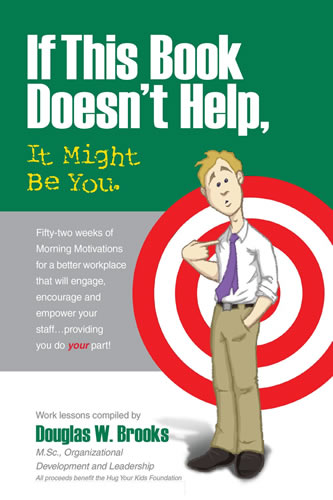Signs your workplace is toxic — and what to do about it.
Most toxic workplaces share the same basic traits. Top performers routinely quit, changes come without warning, and conversations tend to be muted. Actually, after a while, the top performers stop signing up altogether as word gets out. The management, meanwhile, blames the market, the employees, millennials, “hard choices,” the budget, the competition, selfishness, but never, ever themselves.
“They force the really good performers out, they really force the good people out, and you find this when you start asking questions in an organization about productivity,” said Douglas W. Brooks, founder and chief pursuer of excellence at Nexus Hospitality, a workplace culture and hospitality industry consulting firm. “Where does that culture start? It starts on top. It starts directly, or by osmosis, from the top. The corporate culture resides in those people who embody the culture.”
Brooks recently published If This Book Doesn’t Help, It Might Be You: 52 Weeks of Motivation for Your Workplace, a book that includes week-by-week advice for managers hoping to take on and turn around a toxic workplace culture. Advisors Magazine called Brooks in September to interview him about the book, and about how workplaces become toxic in the first place.
First, what makes a workplace toxic and why does it matter? A 2018 study in the International Journal of Environmental Research and Public Health reported that, “[Eighty percent] of the issues and concerns regarding employees’ productivity are related to the type of work environment in which they operationalize their assigned tasks.”
Toxic workplaces dampen productivity – in the short-term, a toxic environment can actually boost productivity, but the burnout that follows has a net negative long-term effect, other studies have shown – and the increased stress can even damage employees’ health. It should not surprise anyone, then, that talent flight sets in quickly once a workplace turns toxic. The employees left behind, meanwhile, can start to normalize toxic behavior, Brooks said.
“Those people that are in a toxic work environment often find themselves being sucked into the toxic work behavior so that, all of a sudden, it becomes a comfort zone for them and they know what to expect,” he said. “A lot of it is survival and fear and a lot of it is that people get sucked into this attitude of, ‘I know how to manipulate or manage this environment.’”
 Brooks’ book uses the 52-week format because he assumed, likely correctly, that executives and senior managers would not have the time or focus to sit down and read a book cover-to-cover. For managers who understand what it means to build an inclusive, positive workplace culture, the book does offer useful reminders to avoid sliding backwards, but nothing new. Managers who don’t get it, meanwhile, probably won’t pick up the book in the first place, although Advisors recommends giving your boss a copy on your last day.
Brooks’ book uses the 52-week format because he assumed, likely correctly, that executives and senior managers would not have the time or focus to sit down and read a book cover-to-cover. For managers who understand what it means to build an inclusive, positive workplace culture, the book does offer useful reminders to avoid sliding backwards, but nothing new. Managers who don’t get it, meanwhile, probably won’t pick up the book in the first place, although Advisors recommends giving your boss a copy on your last day.
The toxic workplaces can feel the same regardless of geography, culture, industry, even country. The secrecy around mundane things, the constant, panicked changes to policy and staffing, the lack of candor regarding challenges, the constant put-downs, these toxic elements tend to be similar across time and space. The language, location, and product change, but the toxic elements remained more or less identical.
“My attempt with the book is that it’s really designed to be a recipe guide for people that don’t know the answers, and they know they don’t know the answers and they’re not stubborn enough to avoid asking for help,” Brooks said. “Asking for help is a sign of strength, not a sign of weakness.”
Great advice, if managers take it.
The first step toward fixing a broken corporate culture, Brooks said, is “appreciative inquiry.”
“Figure out what’s causing the toxic culture, and that’s easier said than done,” Brooks said, adding that the book touches on how to ask, listen, and process what employees tell you. “Then bring in people who won’t make it worse or take others down with them.”
Brooks knows first-hand what it takes to create a positive workplace culture, having started up The Ritz-Carlton Hotel Company’s operations in Jamaica. He interviewed 25,000 candidates for 1,000 open positions, he said, and made sure to treat each applicant well regardless. Naysayers on the island told Brooks he would struggle to meet Ritz-Carlton’s standards with a Jamaican workforce; within six months his team had won every award the company could give, he said.
Toxic workplaces are ubiquitous everywhere, and Jamaica was no exception, Brooks said. The island nation’s history as a slave-trade hub during the 1800s contributed to creating negative workplace behaviors that still persist.
“When somebody gets promoted, often their attitude is ‘It’s my time now,’” said Brooks, adding that this creates a cycle of managers mistreating subordinates despite having been mistreated themselves.
Brooks set out to build a supportive work culture from the start. That meant leading by example to preempt any toxic elements from forming.
“When the employees realize that you’re walking the talk then they’ll change,” Brooks said.
For new managers stepping – knowingly or unknowingly – into a toxic work culture or for entrepreneurs building a new workplace from the ground up, If This Book Doesn’t Help offers valuable insights and even provides a useful 52-week structure to avoid overwhelming readers. Filled with practical tips, the book serves a noble purpose, but most of the people who need the advice will likely be unwilling to take it.
“They always say it’s not me, it’s them. Well, who are they?” Brooks said. “They’re you.”
If This Book Doesn't Help, It Might Be You is available on Amazon. And to learn more about Douglas W. Brooks, visit nexushospitality.com



